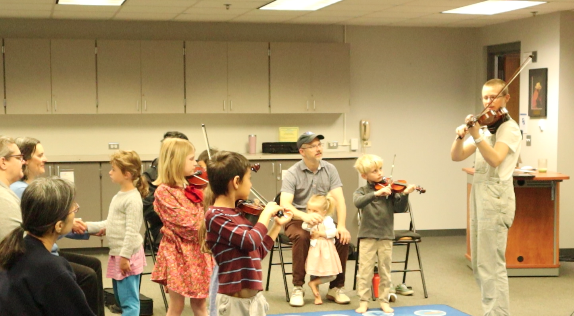
I’m starting my fourth year of teaching the pre-twinkle group class at Ithaca Suzuki Music Education (ISME).
I love this class! I don’t take it for granted that I am setting up the foundational experience for group class for violinists in our school.
Before I jump in with the details, I should share the context for how students start in our program.
Enrollment
We enroll new students in September and January. Our enrollment process includes three Suzuki Parent Education Sessions with the Co-Directors, two non-instrument specific classes called “Sparklers,” and a series of observations (some in person, some on video).
In our program students pay an all inclusive monthly tuition. Tuition includes weekly individual lessons (starting at 30 minutes), weekly group lessons (60 minutes), recitals, concerts, community events, parent talks, and workshops.
They start group lessons at the same time as individual lessons.
Principles
These are a few principles I have used to guide my Pre-Twinkle group class.
What is Group Class for?
I have two goals in group class. 1) To learn from each other (community) and 2) to play together (ensemble). The teacher facilitates the class, but the children are learning way more from each other than they are from me.
We want to get them in a room with other violinists every week so they understand that other kids learn to play the violin, too.
In class I am constantly returning back to “playing like one violin.” That can be expressed via singing, moving, clapping, plucking, bowing on the shoulder, bowing on open strings, or playing a piece. At every step of the way I’m training them to work in unison.
When Parents Participate, They Participate Fully
Most of the kids in this class are 3 and 7 years old. They have a very strong bond with their parents. They will carefully model whatever the parent does. And parents are on their best behavior.
I’ve found, by involving the parents, that the kids understand how to work with me, how to listen to instructions, where to put their attention, and what to do. Added bonus: parents double the size of your class.
Including parents will also give you the chance to give the parent direct feedback on how they are working with their child. Are they gentle as they form the bow hand? Could the violin be slightly angled on the shoulder? Could we use a different tone of voice? Those are things I can point out in group that I might never get to see in our individual lesson.
The biggest thing I have to do is set parents free. Encourage them to be silly, goofy, wacky, and have fun with it. This is great training for home practice as well.
Include as much music as possible
It can be hard to get much music making into lessons when kids are little, don’t have their instruments and aren’t playing yet. I can compensate for this in group lessons.
In our school we hire pianists to accompany every group lesson and I think it’s absolutely vital for pre-twinkle class. Here are some other ways I incorporate music making
- Speaker that plays music while everyone walks in
- Speaker to play music that teaches a concept (different instruments, different styles, different ensembles, different cultures of music, tempi, dynamics, etc.)
- Teacher can give a “performance” in class, students can practice their listening skills
- You can invite an older kid to come give a performance or demonstration
- Singing together!
- Movement activities based on a piece (walk in a circle: when I play forte you stomp, when I play piano you tiptoe)
- Musical instructions (I sing “please pick up your violin” (up the scale))
Teach the Parents
It’s easy in class to feel like the teacher is meant to teach the students. Or even, the teacher is meant to be a circus leader of activities.
The group lesson is as much a lesson as the individual lesson is. We do group activities, but we give tailored, individual feedback during class.
I learned from Zach Sweet, one of the teacher trainers at our school, that you can play with the kids on one plane, but also talk with and teach the parents on another. He is really good at commenting on what is happening in the class and finding teachable moments for parents to observe.
He has taught me to say things like, “Notice how at the beginning of class we had students hanging back on the edges and now they are fully participating.”
Or, “When this student uses these fingers we get a clear pitch like this.”
Or, “When I move my hands in this way, I get this result.”
Look for teachable moments like these and highlight them for the parents/adults in the room. The students won’t mind, and the parents will benefit so much.
Next week I will post 20 pre-twinkle games we can play in group class before students get their violins.

Leave a Reply